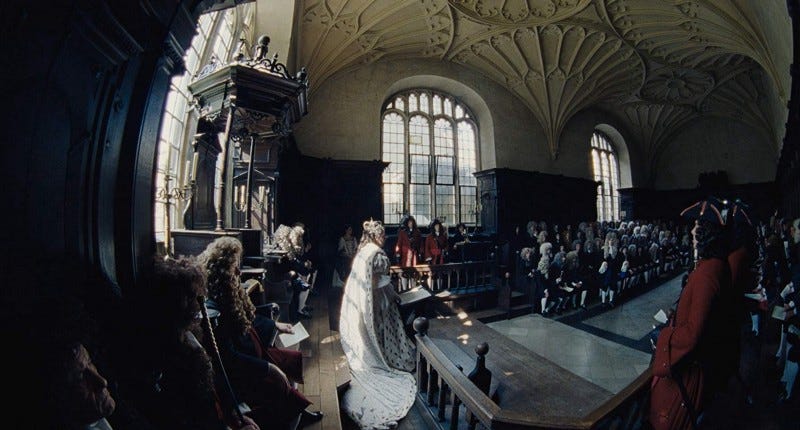The Favourite (2018) is the seventh feature film by greek director Yorgos Lanthimos. It’s a 119 minutes color film, photographed on super 35 film in 1.85 aspect ratio by irish cinematographer Robbie Ryan.
The film tells the story of how Abigaïl , played by Emma Stone, a young servant, of an aristocrat but failed family, manages to become the new favourite of the queen Anne of Great Britain (1665–1714), played by Olivia Colman, in the place of lady Sarah, portrayed by Rachel Weiscz. Abigaïl and Sarah struggle against each other, one to gain power and be safe, and the other to keep the power she enjoys having and using, while queen Anne is a tragic, grotesque and touching character, childless, tortured by gout, bulimia, on the verge of madness.
The performances of the three actresses are excellent. Rachel Weiscz is hieratic and cold-blooded while Emma Stone is wild and fiery. Olivia Colman is amazing, her queen looks in turn risible, touching, weak, playful, scary, pathetic. I remember her in british comedies, especially the TV series Peep Show, where she already displayed her gift for expressing pathos and emotion in the realm of comedy. The smaller roles, like the ones of Mark Gatiss, seen in The League Of Gentlemen and Nicholas Hoult in Mad Max: Fury Road, are excellent too.
There is a sense of jubilation in the film, brought about by the excellence of the film making and the feeling of breaking the rules. The mostly naturally lit cinematography by Robbie Ryan is astounding. I also loved his work in Wuthering Heights by Andrea Arnold in 2011. It’s certainly interesting to see extreme wide lenses used very often, and very often moving very fast, like whip-pans in a forward dolly, in a period setting. Unlike modern fast-paced movies using fast shots, post TV coverage shooting, and long lenses to mimic excitment, The Favourite uses extremely short lenses that allows us to access a never seen before view into a 18th century movie. The audacity, speed and urgency of the cinematography certainly reinforces the seeming sense of actuality given by the incredible greed and egotism displayed by the two favourites.
The use of modern tropes in the period drama setting is not as obvious as it is for example in Marie Antoinette (2006) with its use of trendy rock selections juxtaposed to to the 18th century backdrop. The dancing scenes in The Favourite use very funny semi-modern choreography, some of the clothes fabrics are very modern and sharply cut, and that’s about it. The use of music is very effective, using bits of classical instruments as ambient music between classical pieces by Bach, Handel and Schubert.
My main critic would be that the ending does not follow the same tonality as the rest of the movie. After such an intense ride you expect it to end in a magnificent crash but to my regret it ends by slowing bitterly until nothing moves anymore.
It is nevertheless a very interesting film, dark, funny and dazzling, that owes more to The Draughtsman’s Contract than it does to Barry Lyndon. It displays Yorgos Lanthimos skills in an until then unfamiliar territory for him.





